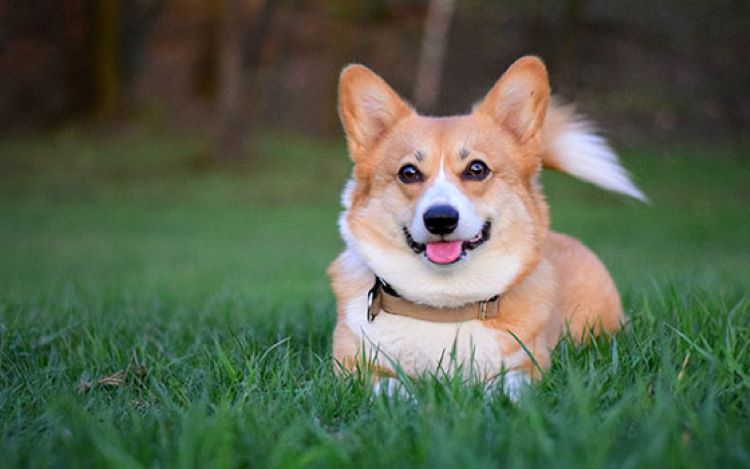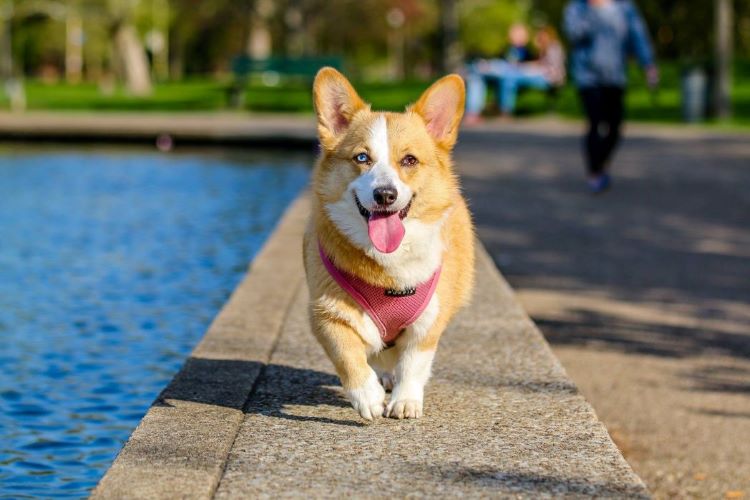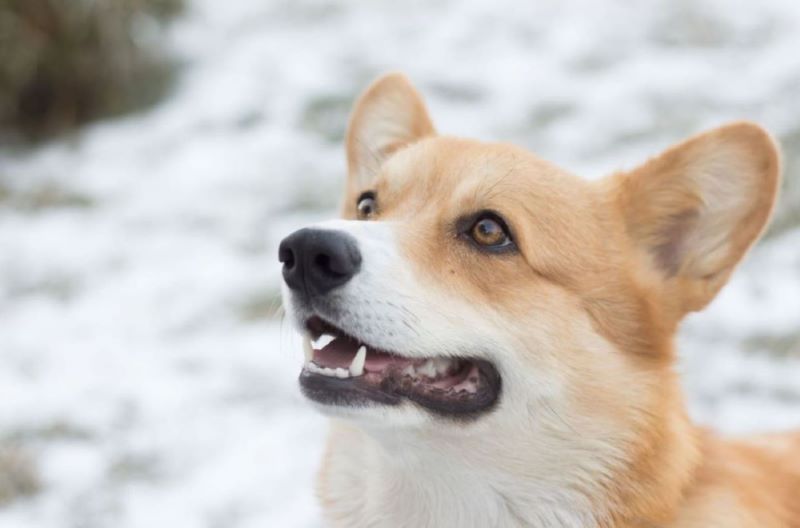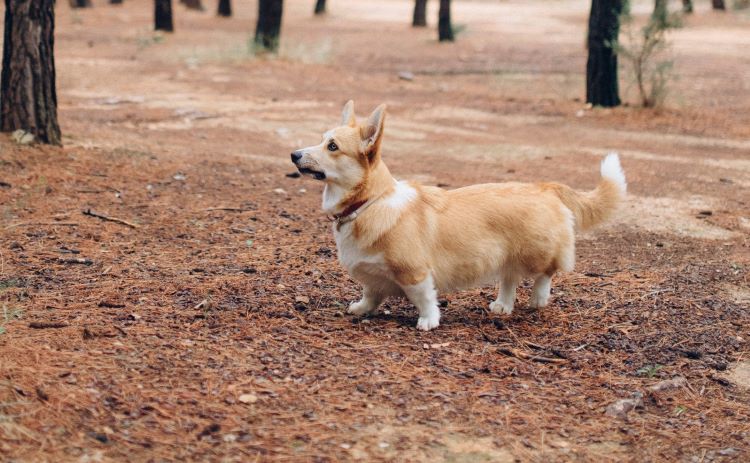Ready to help treat your pet to a healthy life?
Pembroke Welsh Corgi Breed Details & Fun Facts
By : Trupanion Staff | Updated Feb 14, 2024

Who doesn't love a Corgi? These famously adorable dogs have faces that somewhat resemble foxes and are recognized for their short statures and cartoonishly cute appearances. But there's so much more than meets the eye. Not only are there various myths and misunderstandings surrounding Pembroke Welsh Corgis, but these canines are highly intelligent and make for agile working dogs. As many experienced owners of the breed will tell you; never underestimate a Corgi.
Whether you're considering welcoming a Pembroke Welsh Corgi into the family or simply are curious about the breed, you've come to the right place. We're all about pets here at Trupanion, and we've put together these comprehensive dog breed guide on the Corgi. Read on for fun facts, history, breed basics, care tips, and more!
Fun facts about the Pembroke Corgi
- One of two breeds of Welsh Corgi, the Pembroke is so named for the Pembrokeshire county of Wales where it originated.
- Rufus, a Pembroke Welsh Corgi, was the unofficial mascot for Amazon during their early days. The company credits him with creating the foundation for their dog-friendly workplace policies.
- As a well-known Corgi owner, Queen Elizabeth II was instrumental in popularizing this breed. Her first Pembroke, who she called “Dookie,” she received as a gift in 1933 from her father, King George VI. The Queen’s Corgis appeared alongside her and actor Daniel Craig during the 2012 London Olympics opening ceremony.
- In 2014, the Kennel Club placed Pembroke Welsh Corgis on their “vulnerable” breed list, as registrations of puppies dropped below 300 in the United Kingdom. But don’t worry — Pembrokes continue to rise in popularity in the United States and are a favorite social media star. According to the AKC, Pembrokes were the 13th most popular dog breed in the United States in 2018.
- With such a long name, many Pembroke Welsh Corgi owners refer to the breed as “Pems,” PWCs,” or simply “Pembrokes.”
- Pembrokes are the smallest herding breed, but don’t let their short legs fool you! They are quick and agile, and their short height makes it easier for them to dodge the kicking hooves of cattle.
Pembroke Welsh Corgi breed description
There's a good chance you already know what this dog looks like, thanks to its unique appearance and stature:
- Pembrokes have a fox-like face and large ears.
- These low-riders have short legs and a long, sturdy body weighing between 20 and 30 pounds and standing between 10 and 15 inches tall.
- Known for their bobbed tails, docking is becoming less common for this breed. More and more Pembrokes are sporting a longer tail.
- Often referred to as loaves of bread, Corgis tend to have adorable fluffy butts.
Pembroke Welsh Corgis are also full of personality and up for anything. Truly a big pup in a small body, these athletic herding dogs love to work and play. Their intelligence makes them easy and fun to train, but many Corgi owners will tell you that they often are “too smart” — their brains are always on the go!
With their expressive faces and quirky personalities, Corgis are excellent companions that will endlessly entertain. Demanders of belly rubs and opinionated orators, Pembrokes love hamming it up. Get used to hearing people exclaim, “It’s a Corgi!” and come over to say hi. Affectionate and loving, without being needy, a Corgi is a delight to share your life with.
Similar dog breeds
- Cardigan Welsh Corgi
- Swedish Vallhund
- Schipperke
- Dachshund
How to tell a Pembroke Welsh Corgi apart from a Cardigan Welsh Corgi
Look for ears that are a bit pointier at the tips, a smaller size than their Cardigan cousins, straighter legs, and a bobbed tail (or a shorter tail, if undocked). Pembrokes only have four different color patterns, while Cardigans come in a wider variety of colors.

History of the Pembroke Welsh Corgi
One of six dog breeds originating in Wales, the Pembroke Welsh Corgi’s origin story is a mix of fairy lore and the need for an industrious and well-rounded farm dog. In Welsh folklore, the fairies gifted two of their Corgi steeds to the children that found them, and the dogs became an indispensable addition to farm life. It’s said that fairies would have Corgis pull their carriages and ride them into battle, which is why they have a distinctive “fairy saddle” on their neck and shoulders, where the color and fur pattern is slightly different than the rest of their body.
The Pembroke are most likely descendants of short-legged dogs brought by Flemish settlers to Wales in the 12th century. They were excellent working dogs that helped these settlers continue their agrarian way of life in herding cattle and other livestock. These dogs were descendants of the Pomeranian, Schipperke, and other Spitz-type breeds that were used as working dogs in northern Europe for centuries.
Having been around quite a while, the Pembroke Welsh Corgi was bred specifically for their sturdiness, working abilities, and good temperament rather than looks. It wasn’t until 1920 that the Kennel Club officially recognized the Welsh Corgi breed.
Changes over time
When first recognized, the Welsh Corgi breed included both the Pembroke Welsh Corgi and the Cardigan Welsh Corgi. It wasn’t until 1934 that they were recognized as two separate breeds.
The Pembroke Welsh Corgi rose to fame after becoming the preferred dog breed of Queen Elizabeth II. Her first Pembroke was a gift from her father, King George VI, in 1933. He was dubbed “Dookie” by the then-princess, and she became a significant influencer for the breed throughout the 20th century. Queen Elizabeth had well over 30 Pembroke Corgis throughout her lifetime but discontinued her breeding program in the early 21st century.
While the popularity of the Pembroke Welsh Corgi has declined in the United Kingdom over the last decade, with only 274 Pembroke puppies registered with the Kennel Club in 2014 (compared to 34,715 Labrador Retriever puppies registered in the same year), they are in no danger of “going extinct.” Their popularity spiked again in the United Kingdom in 2015, and they have consistently ranked in the top 20 most popular dog breeds in the United States into the 2020s.
North American History of the Pembroke Welsh Corgi
The Pembroke Welsh Corgi has become a popular breed in the United States, having been recognized by the American Kennel Club in 1934. Breeder Lewi Roesler’s Pembroke “Little Madam” was the first registered Corgi, arriving in the U.S. from London just a year earlier. Their excellent personalities, adaptability, size, and the media coverage of the Queen’s corgis back in England, helped them skyrocket in popularity. By 1998, the Pembroke was ranked as the 37th most popular dog breed, jumping to the 13th most popular spot in 2018. The breed has also taken over social media. Corgis are a favorite on Instagram — many puppies having their own accounts and huge followings.
History of tail docking
Though corgis are broadly known for having short, stubby tails or no tail at all, this is not their natural appearance. Just like the Cardigan Welsh Corgi, the Pembroke naturally has a longer, often fluffy-looking tail (often with a white tip at the end). In the US and Canada, it is common to dock (remove) the tail while Pembroke Welsh Corgi puppies are between two and five days old. This is because it is historically considered the "breed standard" for the dogs in conformance with the AKC and CKC, though it is not a common practice for Cardigan Corgis.
Though it is unclear exactly when Corgi tail docking started, it is believed to have been done to make the dogs less likely to get caught or trampled upon by cattle they were herding. The practice is gradually becoming less prevalent in North America and has been made illegal in several countries (including the United Kingdom) in the interest of animal welfare and anti-cruelty efforts.

Behavior and training
Pembroke Welsh Corgis can be wonderful at picking up dog training, as they are smart, fast, and love to solve problems. Their (often excessive) love of food means that positive reinforcement training is a breeze. They also find play and attention from their owners a valuable reward. Keeping their minds engaged and providing them with enough exercise is essential in preventing them from transferring their herding instincts to people or other animals in the home.
Do Corgis get along with others?
Pembroke Welsh Corgis tend to be more sociable than their Cardigan cousins. Their affable personality, paired with their adorable looks, makes them a constant magnet for attention. This means socialization as a puppy is crucial for this breed! Proper proactive exposure to new sights, sounds, people, dogs, and other animals as a young puppy will help develop their socialization skills.
The Corgi does well with children in the home. Their sturdy build makes them better able to handle all the attention, and they love to run around and play. However, due to their herding instincts, they might nip at heels when overexcited. Young children and dogs should always be supervised, and it’s helpful for a dog to have their own “safe space” where they can go when they need some quiet time.
Corgis can do well with other animal companions. As a herding breed, their instinct to chase needs to be addressed from a young age. With proper socialization, training, and consistent management, this won’t present a problem. As with all dogs, Corgis should be supervised during play to make sure they don’t overwhelm other dogs or cats. They like to herd, nip, and bark during their play, which some dogs aren’t sure how to handle — simply step in if the play is getting too rambunctious and someone needs a break.
Exercise and mental enrichment
While small, Pembrokes require more exercise than other dog breeds of their size. They were bred to run and herd all day, even with those short legs! Many Corgis enjoy hiking and swimming beyond their daily walks and games of fetch in the yard.
It’s essential to keep a Pembroke’s brain engaged with mental enrichment. These herders were born to solve problems and work independently. Mental enrichment will help keep them entertained and prevent unwanted puppy behaviors. Teach new tricks, attend obedience classes, join a dog sport, and provide dog puzzles and interactive toys for your Corgi to live its best life.
Does the Corgi have any behavioral issues?
As a herding dog, Pembrokes tend to nip, chase, and bark when they get overexcited. This can be addressed as puppies, helping them learn boundaries and how to calm down when asked.
Because Pembroke Welsh Corgis are such an intelligent breed, training is imperative to prevent unwanted behaviors that will crop up if they get bored. Positive reinforcement training will help you and your Corgi build a strong bond and teach them what to do instead of barking or nipping.
Activities for Pembroke Welsh Corgis
Pembroke Welsh Corgis do well in many different activities:
- Search and Rescue
- Herding
- Treibball
- Agility
- Rally Obedience
- Flyball
- Therapy Work

Pembroke Welsh Corgi grooming and care
Pembrokes have a thick double coat that ranges from a smoother and close-to-the-body length to what’s referred to as a “fluffy” length. Pems have four different colors: fawn, sable, red, and black and tan - all with or without white markings.
Pembrokes shed. They constantly shed. No matter the length of your Pembroke’s coat, they will still shed. Have we mentioned they shed? Regular brushing will help keep the Corgi fur that’s floating around your home at a manageable level, especially during extra seasonal shedding that you’ll see in the spring and fall. This brushing will also help keep their skin and coat healthy by distributing natural oils and preventing tangles. Set yourself and your Pembroke up for success by introducing them to positive brushing experiences as a puppy.
Best Brush for a Pembroke Welsh Corgi: Slicker brush, pin comb, undercoat rake
Corgi pro grooming tip
It’s not advised to clip a double-coat, as it can result in uneven grow out, damage to the hair follicles, and an increase in the chance of sunburn and overheating. A double coat, when well-maintained, actually helps keep a dog cool, facilitating airflow across the skin. If you decide to have a double-coated breed like the Pembroke clipped, whether per your veterinarian’s advice in dealing with skin issues or personal preference, it’s important to choose a groomer that knows how to avoid damaging the undercoat. Keep in mind that trimming will not reduce shedding. A Corgi will simply shed shorter (and often more prickly) fur. Regular brushing is your best bet to keep shedding hair contained.
Pembroke Welsh Corgis in pop culture
These adorable, distinctive pups are mainstays across the world of popular culture.
Famous Owners of the Pembroke Welsh Corgi
- Queen Elizabeth (Royalty)
- Stephen King (Author)
- Selma Blair (Actress)
- Kendra Wilkinson (Model)
- Julie Andrews (Actress)
Pembroke Welsh Corgis in books, movies, and TV
- The whole Rowdy of pups in A Very Corgi Christmas
- Tino in A Dog’s Purpose
- The Queen’s Corgi animated film
- Cheddar on Brooklyn 99
- The book "The Corgiville Fair" features a town full of Pembroke Welsh Corgi residents
